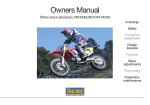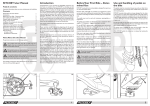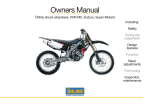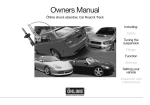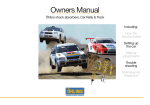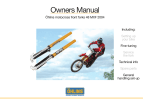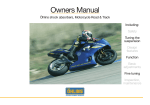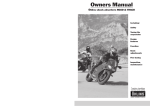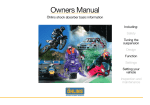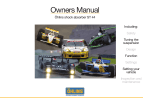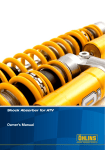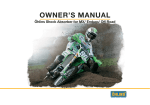Download Owners Manual
Transcript
Owners Manual Öhlins shock absorbers ATV Including: Safety Design features Basic adjustments Technical information 1 Safety signals Important information concerning safety is distinguished in this manual by the following notations: The Safety alert symbol means: Caution! Your safety is involved. WARNING! Failure to follow warning instructions could result in severe or fatal injury to anyone working with, inspecting or using the suspension, or to bystanders. CAUTION! Caution indicates that special precautions must be taken to avoid damage to the suspension. NOTE! This indicates information that is of importance with regard to procedures. © Öhlins Racing AB. All rights reserved. Any reprinting or unauthorized use without the written permission of Öhlins Racing AB is prohibited. Printed in Sweden. 2 Introduction All of Öhlins advanced suspension products are adapted to the brand and model. This means that length, travel springaction and damping characteristics, are tested individually just for the vehicle that you have decided to fit with Öhlins suspension. Before installation Öhlins Racing AB can not be held responsible for any damage whatsoever to shock absorber or vehicle, or injury to persons, if the instructions for fitting and maintenance are not followed exactly. Similarly, the warranty will become null and void if the instructions are not adhered to. Contents Safety signals ................................................ 2 Introduction ................................................... 2 Before installation .......................................... 2 Tuning the suspension ................................... 3 Design ........................................................... 3 Function ........................................................ 4 Settings ......................................................... 5 Preload adjustment ....................................... 6 Setting the damping ...................................... 7 Setting your vehicle: ...................................... 7 Inspection and maintenance ......................... 9 General handling set-up .............................. 10 WARNING! 1. Installing a shock absorber, that is not approved by the vehicle manufacturer, may affect the stability of your vehicle. Öhlins Racing AB cannot be held responsible for any personal injury or damage whatsoever that may occur after fitting the shock absorber. Contact an Öhlins dealer or other qualified person for advice. 2. Please study and make certain that you fully understand all the mounting instructions and the owners manuals before handling this shock absorber kit. If you have any questions regarding proper installation procedures, contact an Öhlins dealer or other qualified person. 3. The vehicle service manual must be referred to when installing the Öhlins shock absorber NOTE! Öhlins products are subject to continual improvement and development. Consequently, although these instructions include the most up-to-date information available at the time of printing, there may be minor differences between your suspension and this manual. Please consult your Öhlins dealer if you have any questions with regard to the contents of the manual. Design principles Shock absorber position Gas Oil Oil Gas Oil Gas Separating piston PDS piston Shock absorber piston 1. 2. 3. 4. Fig.1: External reservoir with hose connection Fig.2: External piggyback reservoir Fig.3: Internal gas reservoir Fig.4: PDS piston shock absorber Tuning the suspension Road holding qualities All vehicles are designed with a suspension geometry that includes wheel movements and angles. The changing of components can affect this and it is therefore essential that both the rear and the front ends match each other. Changing to Öhlins suspension gives optimum performance only when both the front and the rear suspension interact properly. It is of greatest importance that the front and rear loaded heights (ride height sag) are within the specified values in the Mounting Instructions. Design Most of Öhlins suspensions are of the De Carbon type. The fluid is put under gas pressure and the gas and the fluid are kept apart by a separating piston. The separating piston is often fitted in a separate fluid reservoir, connected by hose (Fig.1) or fixed direct on top of the shock absorber (Fig.2) (piggyback). There are also models where the separating piston is fitted inside the main shock absorber (Fig.3) (internal gas reservoir). To obtain a progressive damping system (PDS), the most advanced shock absorber has two pistons. This ensures position sensitive damping in relation to the degree of compression. One of the pistons is active throughout the entire lenght of the stroke, while the second piston begins to work in the event of powerful compression of the shock absorber (Fig.4) Pressurization of the fluid is made with nitrogen. The pressurization prevents cavitation of the fluid and the shock absorbing action is therefore more even. The external fluid reservoirs also contribute to better cooling of the fluid, giving longer service life to both the fluid and components. Öhlins shock absorbers have integrated temperature compensation. As the temperature increases and the fluid flows more easily the flow is controlled accordingly. The shock absorbing effect is therefore independent of the temperature. Öhlins shock absorbers provide the possibility for adjustment, making them adaptable to most vehicles, drivers and ranges of use. All of the shock absorbers, equipped with springs, have adjustable pre-loading of the spring action. The more advanced models permit individual adjustment of compression damping and rebound damping. WARNING! All vehicles are designed with a suspension geometry that includes wheel movements and angles. The changing of components can affect this and it is therefore essential that both the rear and the front ends match each other. Changing to Öhlins suspension gives optimum performance only when both the front and the rear suspension interact properly. 3 5. Flow through needle valve 6. Piston with apertures 7. Shims stack 8. Flow through piston Stop washer Shims stack Compression flow Rebound flow Piston Function The function, in principle, is that fluid is forced through needle valves at a low rate of flow (Fig.5) and through a number of apertures in the piston at a high rate of flow (Fig.6). The flow through these apertures is regulated by shims (thin steel washers) that at high pressure are deflected to open for the fluid (Fig.7). On some models the needle valves can be set individually. By altering the size of the shims stack (i.e. number, thickness, diameter) (Fig.8) the characteristics of the damping action can be varied (this should only be done by Öhlins authorized service workshops). 4 Compression damping When movement of the vehicle causes compression in the shock absorber, the fluid flows through the needle valve (combined compression and return valve) into the piston rod. If velocity of the piston is high, i.e. in the case of rapid compression, this will not be sufficient and consequently the shims underneath the piston will open to allow a greater rate of flow. The fluid that is displaced by the volume of the piston rod is forced into the external fluid chamber via a separate compression valve. Even this valve is fitted with shims that open at high piston velocity. The separating piston is displaced, thus increasing the gas pressure. Rebound damping When the spring presses the shock absorber out again, the fluid flows back through the needle valve in the piston rod. The fluid flowing into the chamber is forced by the pressure of the gas back into the shock absorber via a separate non return valve. If velocity of the piston is high, the shims on top of the piston will also open to allow the fluid to flow though. 9. Adjustment possibilities 10. ATV, steering by sliding Steering by sliding rear end 1. 2. Normal vehicle steering by turning the front wheels in the intended direction 3. Settings Basic settings Always ensure that the basic setting made by Öhlins is correct. It is adapted to the specific make and model (in its original state) and for a rider of average weight. These adjustments are made to optimize the suspension (Fig.9): 1. SPRING PRE-LOAD is when you adjust the spring to match your body weight and weight of your equipment. 2. COMPRESSION DAMPING controls how fast the shock absorber compresses when you hit a bump. 3. REBOUND DAMPING controls how fast the shock absorber returns to its normal position after it has been compressed. Since an ATV has a rear axle without differential it is forced to turn mostly by sliding (Fig.10). Therefore excessively good road holding capabilities is undesirable. The rear end must be able to easily break loose to slide and the front wheels must not have too sharp turning radius, as this could cause the ATV to flip over. The tires are also a very important factor to the ATV's road holding capabilities. Pattern, sidewall flexibility and air pressure affects these characteristics. Changing the dimensions of A-arms, swing arm and linkage will also affect the vehicle's abilities. Because of this it is vital that the suspension is adjustable. Any change of components will demand different settings. To complicate the situation, the technique and skill of the driver will affect the perfomance of the machine. Therefore it is extremely hard to recommend specific settings. The best recommendation is to proceed by trial and error. However, good understanding of suspension design and function will give you the best chance to take advantage of the adjustment possibilities. This is why we only give basic and simple advice on how to set the dampers/shock absorber. Read the manual carefully and start your work. The Öhlins shock absorber will give you all possibilities for fine adjustment to fit you personal desire. WARNING! 1. ATVs are extremly depending on which kind of tires are beeing used. Soft versus hard tires can completely alter the road holding abilities. The suspension must be tuned in after each change of tires. 2. Every change in suspension geometry, i.e. change of A-arms, etc. must be followed by new settings of the shock absorbers. 5 11. Measuring of ride height sag F1 R1 R2 F2 F3 R3 Pre-load Adjustment Fitting the spring and setting the spring pre-load Adjusting procedures: When fitting the spring provided make sure that the basic setting recommended is set. By turning the rings on the shock absorber body you can adjust the springs tension to suit your weight. Hold the upper ring and adjust the lower one to the desired position. Then lock with the upper ring. To make this adjustment properly you must measure the free sag and ride height (Fig.11). WARNING! Pre-load on the spring/springs is very important, because it affects the height of the vehicle and the wheel angles. Consequently, road holding characteristics can be changed, even negatively. Measuring 1. Place the ATV on a stand with the wheels up off the ground. 2. Measure the separate distances from the top center of the axles to a point straight above them on the frame of the ATV. (F1, R1) 3. Place the ATV on the ground and make similar measurements on the axles. (F2, R2) 4. The difference between the first and the second measurement is the free sag. (F1-F2, R1-R2) 5 Adjust your spring pre-load so that your free sag is within the limits below . 6. Wear all your riding gear. Sit on the seat with your feet on the pegs in correct riding position. Have someone repeat the measuring procedures. (F3, R3) 7. The difference between the first and the third measurement is the ride height. (F1-F3, R1-R3) 6 8. Check that the ride height is correct according to the Mounting Instructions, Set-up data. 9. After trial running the ATV, make further adjustments if necessary. NOTE! If the adjustments do not result in the correct values it is necessary to change the springs. If ride height is too low, change to a stiffer spring; if too high change to a softer spring. Recommendations Recommended ride height (F1-F3, R1-R3) settings are provided in the Setup data of the Mounting Instructions. Free sag (F1-F2, R1-R2) recommendations are not given for all models; for those models the general recommendation is 30±5 mm. 12. Adjustment of rebound damping 13. Adjustment of compression damping 14. High and low speed compression damping adjusters High speed - + + + = more damping - = less damping + - Setting the damping The adjusting possibilities of the advanced Öhlins shock absorbers facilitate fine setting. You can optimize adjustments to suit your own vehicles weight and equipment, your individual way of driving and the condition of the road. To be able to improve the road holding qualities it is of the utmost importance that you fully understand the functioning of the shock absorbers. Then you can learn by trial and error how they affect the vehicle. Depending on model there are adjustments for rebound and compression damping. They have a normal right-hand thread. By turning clockwise they increase the damping action and counter clockwise they reduce it, see illustrations above. The knobs have definite positions with a noticeable “click”, so it is easy to count to the right setting. NOTE! If no “click” is felt, the shock absorber must be inspected by an authorized service workshop. It could be due to low gas pressure or lack of oil. Low speed + Setting your vehicle Rebound damping action affects the characteristics of the vehicle the most. The setting knob is located at the bottom on the piston rod (Fig.12). It can be adjusted in about 40 steps. Compression damping is set with a knob or a screw on top of the external reservoir (Fig.13). This can be adjusted in about 25 steps. Some models (PRX and PRXQ) have separate adjusters for high speed and low speed compression (Fig.14). Low speed adjustments is adjusted in 25 steps. The high speed adjuster has a wide range within four (4) turns. Adjust a half turn (180°) at a time. NOTE! When making new adjustments it is easiest to go to fully closed and then count forward to the new setting. The adjusting knobs should not be turned in too hard. When possible, use fingers only. The adjustment should be made when the shock absorber is cold. NOTE! Always begin with the basic settings recommended by Öhlins. Always make notes, adjust in small steps and make only one adjustment at a time. Adjustments should be made in small steps (few clicks) at a time. By utilizing the adjustment possibilities you can test by trial and error, and learn how they affect your vehicle. Always begin by test driving with all adjustments at their basic setting. Choose a short run of varying character, i.e. long and sharp bends, hard and soft bumps. Keep to the same run and make only one adjustment at a time. 7 15. Rebound damping • Unstable • Loose • Bouncy • Hard • Bumpy Increase Start with the rebound damping (Fig.15) If the vehicle feels unstable, loose and rather bouncy then the rebound damping should be increased. Begin by turning the adjusting knob 4 steps (clicks) clockwise, according to page 7. Test run again and adjust two steps back if it feels too hard and bumpy. If the vehicle is hard and bumpy, especially over a series of bumps, then the rebound damping should be reduced. Turn counter-clockwise 4 steps, test run and make any necessary correction by 2 steps. Reduce 16. Compression damping • Soft • Low • Bottom • Harsh • Hard Increase Compression damping (Fig.16) If the vehicle feels soft, has low riding position and a tendency to bottom easily in long dips then the compression damping should be increased. Screw clockwise 4 steps and test run again. If this was too much then turn back two steps (counter clockwise). If the vehicle feels harsh and has hard resilience, e.g., over changes in the riding surface, then the compression damping must be reduced. Turn counter clockwise 4 steps. Test run and make any necessary correction to two steps. When you have sufficient feel of the vehicle then you can make further fine adjustments. It is feeling and experience that counts. Decrease NOTE! Ensure that the springs are properly pre-loaded before attempting to make any adjustments. A simple rule is that increased pre-load of the spring should be followed by an increase of rebound damping. When you feel that you have achieved an improvement, go back to where you started and check once more. Be observant of other relevant factors such as tires, temperature, etc. Test run to make sure whether further fine adjustment should be made. WARNING! Never alter gas pressure. Special purpose charging equipment and access to a nitrogen source is required. The gas pressure should normally never be altered. 8 3 4 3 2 5 5 1 6 1 17. Lift the bump rubber and clean the area below. 18. Inspection points: Inspection and maintenance Clean the shock absorbers externally with a soft detergent . Use compressed air . Be careful that all dirt and debris is removed. Lift the bump rubber and clean the area below (Fig.17). Keep the shock absorbers clean and always spray them with oil (QS 14, WD40 or CRC 5-56 or similar) after washing the vehicle. CAUTION! Never use detergents that can damage the surfaces of the shock absorber. Use of thinner and brake cleaner will dry the surfaces too much. NOTE! Make certain that your shock absorbers are always filled with Öhlins High Performance Shock Absorber Oil. Inspection points (Fig.18): 1. Check ball joints for possible excessive play. NOTE! Regular maintenance and inspection contribute to the prevention of functional disturbances. 2. Check the piston shaft for leakage and damage. 3. Check the shock absorber body for external damages. Recommended inspection and maintenance intervals: 4. Check the external reservoir for damages that can restrict the floating piston from moving freely. Normal use Race track 2 - 3 times a year Every ten hours 5. Excessive wear of rubber components. 6. Fastening to the vehicle. Preventive maintenance and regular inspection reduces the risk of functional disturbance. If there is any need for additional service, please get in touch with an authorised Öhlins service workshop. There they have the necessary tools and knowhow for whatever you need. Once a year, general: Change shock absorber oil. Use Öhlins shock absorber oil only. NOTE! Discarded Öhlins products should be handled over to an authorized work shop or distributor for proper disposal. 9 General handling set-up Front suspension. Front end falls into the curves (oversteering) especially in sand. Front end too low in comparison to rear end. Suspension travel is not used to its full capacity. Harsh feeling, front wheels’ grip is not satisfactory in bumpy turns. Suspension too hard. Feels harsh over small bumps, but using full wheel travel. Too much spring pre-load or too much compression damping. • Decrease the compression damping. • Change to softer springs. • Change to softer springs. • Decrease the compression damping. • Decrease the spring pre-load. Suspension bottoming, too soft during entire travel. Springs too weak or compression damping too soft. Can handle the first in a series of bumps but feels hard after a few more bumps. Frontal grip insufficient in rough and bumpy turns. Too much rebound damping. • Increase compression damping. • Change to stiffer springs. • Decrease the rebound damping. • Increase the front compression damping. • Change to harder springs. Front end ”ploughs”, understeers. Front end too high in comparison to rear end. • Decrease the front compression damping. • Change to softer front springs. Front end unstable at high speed, unstable when accelerating out of curves. Front end too low in comparison to rear end. • Change the front springs to harder front springs. Front end unstable during deceleration. Front end too low or rear end too high. • Change to harder front springs. • Increase the shock absorber compression damping. Suspension bottoming, but can handle smaller bumps. Damping force not progressive enough. Front end rebound too fast after a bump. Front wheels’ grip insufficient in bumpy curves. Not enough rebound damping, or too much spring pre-load Can handle smaller bumps but is too hard during the last part of the travel. Damping force is too progressive. • Increase the rebound damping. • Decrease the spring pre-load. Front end feels low, initially feels soft, but is not bottoming. The initial spring rate is too soft or spring preload is too low. • Increase the spring pre-load. 10 Rear suspension. Rear suspension stroke is not used to its capacity. Suspension feels harsh. Traction not satisfactory in bumpy curves. Suspension hard in general or too much compression damping, too much spring pre-load. • Decrease the compression damping. • Decrease the spring pre-load. • Change to softer springs. Suspension is bottoming, feels soft during the entire wheel travel. Spring too soft, compression damping too low. • Increase the compression damping. • Change to harder springs. Suspension is bottoming, feels harsh and sags down too much with the rider in the saddle. Spring too soft or compression damping too low. • Increase the spring pre-load, check ride height. • Change to harder spring if the load is more than recommended in mounting instructions. • Increase compression damping. Rear wheels’ jumps over small bumps during deceleration or when going downhill. Traction not satisfactory in washboard curves. Too much spring pre-load, as the spring is probably too soft, will cause the spring to extend too fast. • Change to a harder springs in order to achieve a balanced position using less springs pre-load. • Check the ride height. Rear end kicks up over bumps with sharp edges, but can handle bumps with round edges. Compression damping too hard. Rear end very unstable. Shock does not respond to adjustments. Shock damping is gone, caused of low gas pressure, bad oil is used, or components are broken in the shock absorber. Service is needed. • Gas filling required. • Change shock oil. • Repair or change the shock absorber. NOTE! Recommended measures are not listed in order of importance. One of the listed measures can be sufficient to solve a particular handling problem. • Decrease the compression damping. Rear end becomes too low in series of bumps. Traction not satisfactory in washboard type curves or when decelerating on washboard ground. Rebound damping too slow. • Decrease the rebound damping. 11 More info Öhlins Racing AB, Box 722, S-194 27 Upplands Väsby, Sweden Phone +46 8 590 025 00, Fax +46 8 590 025 80 Your Öhlins dealer: 12 07235-01. Issued 05 04 12. Teknisk Illustration. www.ohlins.com












